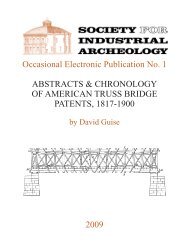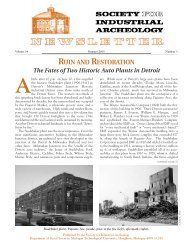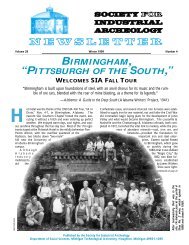RUHR, GERMANY - Society for Industrial Archeology
RUHR, GERMANY - Society for Industrial Archeology
RUHR, GERMANY - Society for Industrial Archeology
You also want an ePaper? Increase the reach of your titles
YUMPU automatically turns print PDFs into web optimized ePapers that Google loves.
SIA members make their way to the engine hall at Zeche Zollern II/IV coal mine.<br />
United Kingdom, Belgium, Luxembourg and the Saar are working<br />
with him, and a master plan is in the works to extend the route to<br />
these countries by 2004 and to all of Europe by 2011.<br />
The German Mining Museum was established in 1930 by the<br />
city of Bochum in partnership with a miners’ educational insurance<br />
association. Bochum was once the largest mining town in Europe,<br />
with 44 mines in operation at its peak. An underground demonstration<br />
mine with 2.5 km of tunnels gives visitors a sense of what<br />
it is like to be in a coal mine, though no mining ever occurred at<br />
this site; the mine serves educational purpose only. Underground<br />
exhibits contain drilling and boring machinery, including a coal<br />
p l o w, and various tunnel support systems. All of it is operational,<br />
and we even got to try our hands at a pneumatic drill. From the<br />
tunnels we took an elevator to the top of the headframe of the<br />
Germania mine, relocated to the museum. We spent several hours<br />
roaming the enormous museum, which held everything from<br />
medieval drinking cups depicting miners to paintings of St.<br />
Barbara, patron saint of miners, to a room full of safety lamps and<br />
headlamps. Such comprehensive central museums were very popular<br />
in the early 20th century, but Wolfgang commented that they<br />
encouraged destruction of sites, rather than preserving them intact.<br />
In the afternoon we visited the Deutsche Arbeitsschutzaus -<br />
stellung (German Occupational Safety Exhibition) where<br />
exhibits of working Jacquard-style looms, printing presses and<br />
steam engines focused on the dangers faced by their operators.<br />
Nordsternpark was our last stop of the day. This 1868 mine site<br />
became the location <strong>for</strong> the Bundesgartenshau (Federal Garden<br />
Show) in 1997. The show focused on the relationship of industry<br />
and nature and resulted in the redevelopment of the site with a<br />
commercial operations in new structures at the north end, a model<br />
railroad club in one on the mine buildings, and a landscape park.<br />
Bike trails and footpaths over the Rhein-Herne Canal connect the<br />
park to others in area towns, creating a vast greenway that attracts<br />
many visitors.<br />
We began the next morning with a visit to the Oberhausen<br />
Gasometer, built in 1929 by the city <strong>for</strong> the storage of coke gas.<br />
The gasholder is one of the tallest in Europe at 117.5-m. high; it<br />
has a diameter of 67.6 m and an effective volume of 347 thousand<br />
cubic meters. It is of the MAN “waterless” type (as built by<br />
Maschinefabric Augsburg Nürnberg). The pressure in the mains<br />
<strong>Society</strong> <strong>for</strong> <strong>Industrial</strong> <strong>Archeology</strong> Newsletter, Vol. 30, No. 2, 2001<br />
was maintained by a piston that “floated” on the contained<br />
gas within a rigid cylinder, rather than by the<br />
weight of the holder cylinder itself as it rose and fell<br />
within its water seal. The relatively light weight of the<br />
piston-, or disk-, type gasholder was well-suited <strong>for</strong> the<br />
foundation conditions in an area that suffered from<br />
mining subsidence. The disk weighs 600 tons, but was<br />
overlaid with concrete to achieve the weight of 1210<br />
tons needed to provide adequate pressure. It went out<br />
of use in 1988, at the same time as the Osterfeld<br />
Kokerei which supplied the gas. When restored in<br />
1998, an arena with seating <strong>for</strong> about 500 was built<br />
atop the disk. From the top of the gasometer we<br />
enjoyed a panoramic view of the Ruhr Valley.<br />
At the Arenberg-Fortsetzung mine, a brief stop, we<br />
saw the newly restored 1904 office building with the<br />
pay hall where workers also checked in each morning.<br />
The skylight was designed so managers could conduct<br />
health inspections. Sick miners were expensive to<br />
carry out from and were not wanted underground. We<br />
then traveled to the Zeche Zollern II/IV . Lunch was<br />
served in the Pferdestall (horse stable), which has been<br />
trans<strong>for</strong>med into a very fine restaurant. The mine was<br />
built in 1902 and miners last went underground there in 1965.<br />
The buildings were rented out to small industries until 1979, when<br />
the machine hall was put under a preservation order, the second<br />
continued on page 8<br />
SIA’s Ruhr Tour host, Wolfgang Ebert, at the Krupp gravesite.<br />
7






